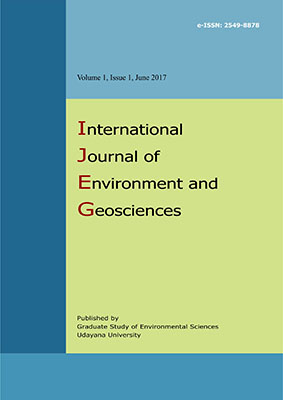Application of GSMaP Product and Rain Gauge Data for Monitoring Rainfall Condition of Flood Events in Indonesia
Abstract
Rainfall is one of main causes of floods. Monitoring of the rainfall is essential for understanding flood mechanism and early warning. Ground-based rain gauge is a conventional device to measure rainfall amount and considered as a point measurement. Satellite-based rainfall estimates provides complement measurement over wide area having few or even no in situ data. This study evaluates rainfall intensity variation and patterns preceding flood events in Indonesia for the period of 2003-2010 using the GSMaP_MVK satellite-based rainfall product with one hour and 0.1o x 0.1o resolutions and rain gauge station data as a benchmark. The analysed data are 3-hourly average and daily accumulation time steps. The chosen research locations were Medan City, Pekanbaru City, Indragiri Hulu Regency, Samarinda City and Manado City. Graphical comparisons of the GSMaP_MVK with the rain gauge data show discrepancies in capturing rainfall events and intensity. The GSMaP_MVK performs underestimation for the most areas, except Samarinda City, which is overestimated. Short-term period rainfall pattern is the most frequent occurred preceding flood events for the entire study areas which indicate that the areas are more susceptible to flash floods and river overflows. Overall, the GSMaP_MVK product provides promising potentiality for the application of monitoring rainfall conditions preceding flood events over the research locations. Statistical verifications reveal that on average, correlation coefficients are (0.22-0.54) and (0.65-0.83) for 3-hourly and daily scale, respectively. While, probability of rain detections (PODs) are (0.57-0.75) and (0.93-0.99), accordingly.Downloads
Download data is not yet available.
Published
2017-03-14
How to Cite
SUGIARTHA, Nyoman et al.
Application of GSMaP Product and Rain Gauge Data for Monitoring Rainfall Condition of Flood Events in Indonesia.
International Journal of Environment and Geosciences, [S.l.], v. 1, n. 1, mar. 2017.
ISSN 2549-8878.
Available at: <https://ojs.unud.ac.id/index.php/ijeg/article/view/28831>. Date accessed: 23 apr. 2024.
doi: https://doi.org/10.24843/ijeg.2017.v01.i01.p05.
Issue
Section
Articles
Keywords
rainfall; monitoring; accuracy; GSMaP MVK; rain gauge; flood events
Authors who publish with this journal agree to the following terms:
- All articles published by International Journal of Environment and Geosciences (IJEG) and Graduate Study of Environmental Sciences, Udayana University are made available under an open access license worldwide immediately. This means everyone has free and unlimited access to the full-text of all articles published in International Journal of Environment and Geosciences (IJEG), and everyone is free to re-use the published material given proper accreditation/citation of the original publication. Open access publication is supported by authors' institutes or research funding agency by payment of a comparatively article processing charge for accepted articles (See Author Fees). International Journal of Environment and Geosciences (IJEG) and Graduate Study of Environmental Sciences, Udayana University publish articles under the Creative Commons Attribution License.
- Authors are able to enter into separate, additional contractual arrangements for the non-exclusive distribution of the journal's published version of the work (e.g., post it to an institutional repository or publish it in a book), with an acknowledgement of its initial publication in this journal.
- Authors are permitted and encouraged to post their work online (e.g., in institutional repositories or on their website) prior to and during the submission process, as it can lead to productive exchanges, as well as earlier and greater citation of published work (See The Effect of Open Access).





